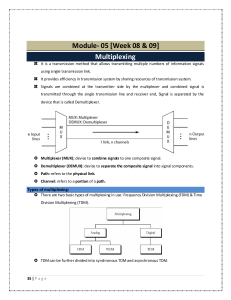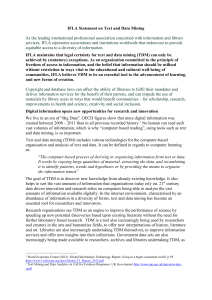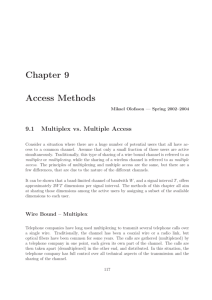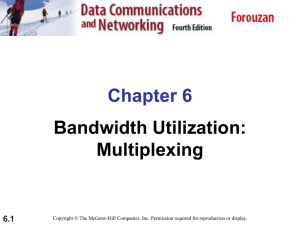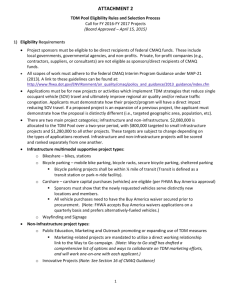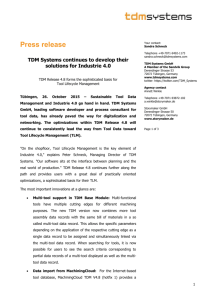m(t)
advertisement
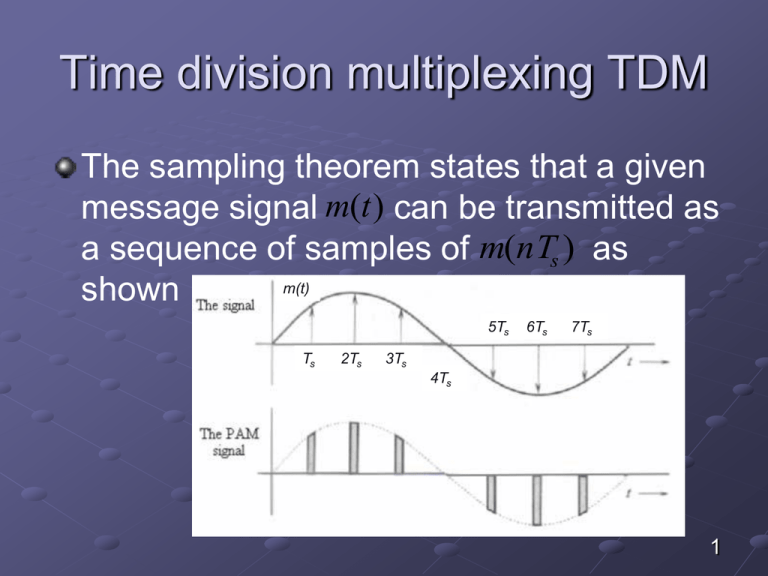
Time division multiplexing TDM The sampling theorem states that a given message signal m(t ) can be transmitted as a sequence of samples of m(nTs ) as m(t) shown 5Ts Ts 2Ts 6Ts 7Ts 3Ts 4Ts 1 TDM graphical representation for two signals This leaves space for other samples to be interleaved in the same sampling interval 2 TDM block diagram In TDM N signals can be transmitted simultaneously using a single channel This can be achieved by using the block diagram shown below Communication channel 3 TDM block diagram The commutator switch takes samples from each input signal and interleave them The operating frequency of the commutator switch is given by f N Nf s Where f s 2 f m is the sampling frequency for each signal provided that all N signals have the same bandwidth 4 TDM block diagram If the N signals have different bandwidths, then f s is selected as the sampling frequency of the signal with the highest frequency content If signals with different bandwidths are to be TDM multiplexed, then the signals with same bandwidth are grouped together and sampled on the same f s 5 TDM example Two signals are to be transmitted using PAM TDM. The first signal has a bandwidth of 0-8 kHz signals, the second signal bandwidth is 0-10 kHz. The two signals are sampled equally. The sampled signals are passed through a low pass filter before transmission 6 TDM example a) What is the minimum clock frequency of the PAM system (commutator clock) b) What is the minimum cutoff frequency of the low pass filter used before transmission that will preserve the amplitude information on the output pulses 7 TDM example c) What would be the minimum bandwidth if theses two signals were frequency multiplexed using normal AM techniques and SSB techniques 8 Example 1 solution a) The minimum clock frequency of the PAM system can be found from f N Nf s N (2 f m1 ) N (2 f m 2 ) f N 2 2 10 kHz 40 kHz b) The minimum bandwidth of the transmission filter can be found from fN 1 BW 2Tn 2 BW 40 kHz 2 20 kHz 9 Example 1 solution • The above equation for the bandwidth can be concluded from the fact that, the transmitted samples can be viewed as a new signal f 3 (t ) sampled at a sampling rate of Tn • This sampling rate is equivalent to a frequency fN 1 2 f m3 Tn 10 Example 1 solution • Where f m 3 is the maximum frequency content of f 3 (t ) • From the above discussion we can see that the cutoff frequency of the filter must 1 be greater than the f m3 2T in order to n pass f 3 (t ) without distortion 11 Example 1 solution c) If the previous two signals were frequency multiplexed, then sent using AM carrier, then the minimum bandwidth would be BW 2 f f m1 m2 BW 2(8 10) 36 kHz If SSB modulation is used then the bandwidth would be BW f m1 f m 2 BW 8 10 18 kHz 12 5.88 4.88 13 14 15
